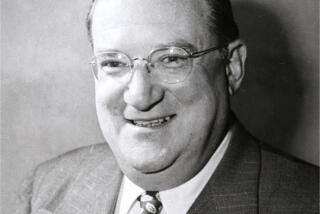Executive’s Disappearance Still a Mystery : Missing: Production has stopped at baseball statue factory and firm has been sold. An employee can’t believe William Alley vanished deliberately.
- Share via
DALLAS — William K. Alley Jr. seemed to fit the same all-American mold as the baseball statues his company made for collectors across the country.
Seventeen years after being married as college sweetheart, Alley and his wife were expecting their fifth child. They lived in an affluent Dallas neighborhood and had a wide circle of friends.
His company, Hartland Plastics Co., was doing more than $1 million a year in business and about to release its third series of Hall of Famer statues.
Then he disappeared.
The 40-year-old Alley, known as Billy to friends and associates, was last seen March 1 leaving a New York hotel, where he was attending a toy and collectibles show. Three days later, when he did not come back home, his wife reported him missing.
Since then, Hartland Plastics has stopped production, leaving some vendors unpaid and orders unfilled. His family has been supported by friends and relatives, as well as strangers and baseball collectors.
“Emotionally, there are times, and I would guess anyone would feel this way, when you think that he’s dead,” said his wife, Pamela Alley. “And there are times of just being totally bewildered because, if he isn’t, then what are the options?
“And speculation has been sort of lethal. Your mind can become your worst enemy, the endless possibilities of what could happen.”
New York police and a private investigator have no leads in Alley’s disappearance.
On March 5, a similar episode occurred in New York. Malcolm Cheek, president of the St. Louis engineering firm Y&A; Group, disappeared after checking into a New York hotel. He left behind millions of dollars in personal debt and a company burdened by credit problems.
Matt Welsh, vice president of production for Hartland Plastics, dismissed the idea that Alley deliberately left the company or his family.
“From all indications I had, he and his wife didn’t have any problems. He loved her and his children,” Welsh said. “I know he wouldn’t do it for money. He had too much confidence in his abilities.”
Still, few details of Hartland’s financial condition can be gleaned from public sources.
At least one small lawsuit is pending against the company in state district court. Hager Containers Inc. of Dallas last spring filed for non-payment of $3,800 for boxes and labels shipped to Hartland in late February.
Pamela Alley said she knows little about the business. Court records also show most of the family’s assets were in her husband’s name.
Earlier this month, Pamela Alley sold Hartland Plastics to Dallas businessman Bill Dunlap after a state district judge granted her control over the couple’s community property. Terms of the deal were not disclosed.
Dunlap, co-owner of Case-Dunlap Enterprises, which produces sports-related and other promotional and souvenir items, said he planned to rename the company USA Hartland Inc. and resume production within three months. Hartland’s 12 employees have been out of work since April.
Between 1957 and 1963, Hartland Plastics Co., then based in Hartland, Wis., sold ivory white, 7 1/2 -inch-tall statues of All-Stars at major league ballparks. The 18 Hartland figures, sold then for about $3 each, have become valuable with collectors.
Those of famous players such as Babe Ruth regularly sell for $200. Statues of less popular players are worth much more because of their scarcity. A statue of Dick Groat, the Pittsburgh Pirates shortstop who was the National League most valuable player in 1960, is advertised for $2,000 in Sports Collectors Digest.
Alley, an attorney, became enamored with Hartland statues when he and his sons took up baseball card collecting a few years ago, his wife said.
“He was fascinated by the look of the Hartland statue. As a parent at this time, with toys like He-Man, the Hartland statue looked so pure,” Pamela Alley said.
Alley bought the rights to the company’s name in 1988, 10 years after it closed. He asked the retired designer of the original statues, Frank Fulop, to help create a commemorative edition.
“They were copies of the original 18 ballplayers with a stamp in the back belt loop that said ‘25th Anniversary’ so they wouldn’t be confused with the originals,” Fulop said. “It was like a newborn baby.
Alley limited production to 10,000 copies of each statue, said Welsh, the production vice president, selling them by monthly subscription to collectors for about $25 each. The company never sold out of a statue model but came close on several occasions, he said.
In addition to reproductions of the original 18 statues, Alley’s artists developed two new series of six statues each. Fulop helped with suggestions for poses and colors.
Tom Mortenson, editor of Sports Collectors Digest, which had written about Alley’s revival of Hartland, said Alley “seemed to be very nice, very personable, a real gentleman. This was quite a surprise to me.”
Pamela Alley, who is due to give birth in September, said the ordeal has been cushioned by helpful friends and the routine needs of her children, ages 13, 11, 6 and 4.
“I do think about him a lot, obviously some days more than others,” she said. “I have the diversion of trying to provide some sense of normalcy and order within our home.”
More to Read
Inside the business of entertainment
The Wide Shot brings you news, analysis and insights on everything from streaming wars to production — and what it all means for the future.
You may occasionally receive promotional content from the Los Angeles Times.










